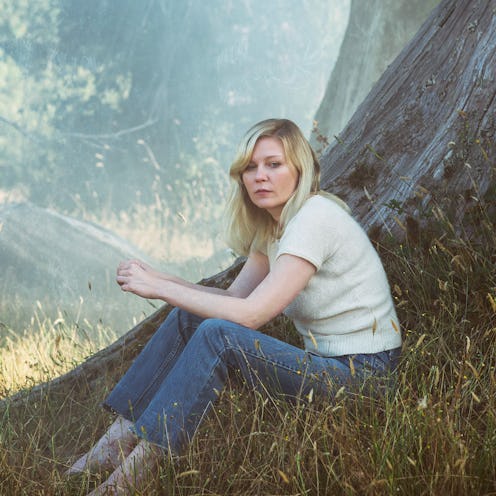When we heard designers Kate and Laura Mulleavy of Rodarte were writing and directing a film, we knew we were in for a cinematic ride. The duo’s clothes often take our breath away with their ultra-feminine details and intricate designs that tell a story. True to form, the sisters’ first film, Woodshock, translates their dreamy aesthetic to the big screen. Starring longtime friend and muse Kirsten Dunst, the moody, visionary film set in the redwoods of Northern California tells the story of Theresa, who deals with a loss by using a cannabinoid drug, leading to an emotional spiral as she copes with grief, guilt and disconnection from reality. It’s an existential film with minimal words, but its focus on majestic sound and visuals immerse you in the story from beginning to end in a unique, thrilling way. We sat down with the Mulleavys to talk inspiration, the difference between designing and filmmaking and, of course, the costumes. Read on for our interview and see Woodshock in theaters now.
The Zoe Report: What's the difference between creating a collection and creating a film?
Laura Mulleavy: "In developing a collection, you take a small idea and you grow it into something. Then, you take it to a theatrical performance that is very temporal and it's fast and it happens one time. This fashion show that you work toward is an imperfect moment, whereas cinema is kind of the opposite. You have this seed, you grow it and you keep perfecting it in each stage that you go through. The process is so completely different from start to completion."
Kate Mulleavy: "I think film is more about understanding that there's something you have a deep desire to communicate to people, and you're now going to use a much broader toolbox to do so. After we screened the movie, people came up to us and, because of its nature, started conversations in which they cried and discussed their own experience of tremendous loss and how this film captured it for them. It's like ripping a boundary apart and just really getting into that open dialogue with someone."
TZR: What made you decide to venture into filmmaking?
KM: I think that we always knew we wanted to make movies. I think that we were developing things through a design language … and at a certain point we just wanted to go deeper. Film as a medium presented itself as a way to flesh out our creativity. We just knew we had to do it.
LM: Yeah, you just know, and then you do anything you can to make it happen. You have to listen to yourself. Life's too short not to listen to those things that can be fulfilling to you.
TZR: What was the inspiration behind the film?
LM: Kate and I grew up in Northern California in a place called Aptos, outside of Santa Cruz, and we were raised around redwoods, which were the inspiration for the film. It's about capturing what those trees make you feel as a human—the smallness and the majesty of the natural world and our connectivity to that, and the disconnect that's happened as well as the destruction that's occurring with the environment. Those things are so interesting and powerful—it's kind of the emblematic landscape for Theresa's journey and very symbolic of her interior space. And wanting to create a stream of consciousness narrative for a woman, that was a big urge within us—to make something internal be external for the viewers and communicate not necessarily through words but through things like touch, sound and emotion.
KM: That's what I think is provocative. It's a very specific female experience, because it's one character, Theresa. She only represents herself. There are many more versions of the female point of view that need to be shown and that we need to experience and see in different voices, but what's interesting about fleshing out her voice is saying we're going to understand her world and landscape through an emotional veil. This is a film based on her inner logic and about the internal experience. I think, as a woman, that was something I felt I wanted to see because, when you really think about it, you don't really get to.
TZR: What was the costume-design process like?
LM: We collaborated on costume design with Christie Wittenborn. The focus is always on Theresa's emotional state. As she gets deeper and deeper into her internal world, something, like the sequined dress shown at the end of the movie, changes throughout the scenes.
KM: It's a film where the costume represents psychology. So it's interesting to play with perfect versions of things—we certainly played with texture. It's such a tactile movie. She's always touching things and to experience her experience, you almost want to touch her. Her fuzzy sweater, for example, played a pivotal role because, when we see it, it makes you understand that there is something very textured about the experience. You can say so much through costume, and Laura and I knew going in that every part of that process would be equally important. Certainly it's amazing to be able to communicate through the costumes.
See the exclusive Woodshock costume exhibit at the Arclight Hollywood.
